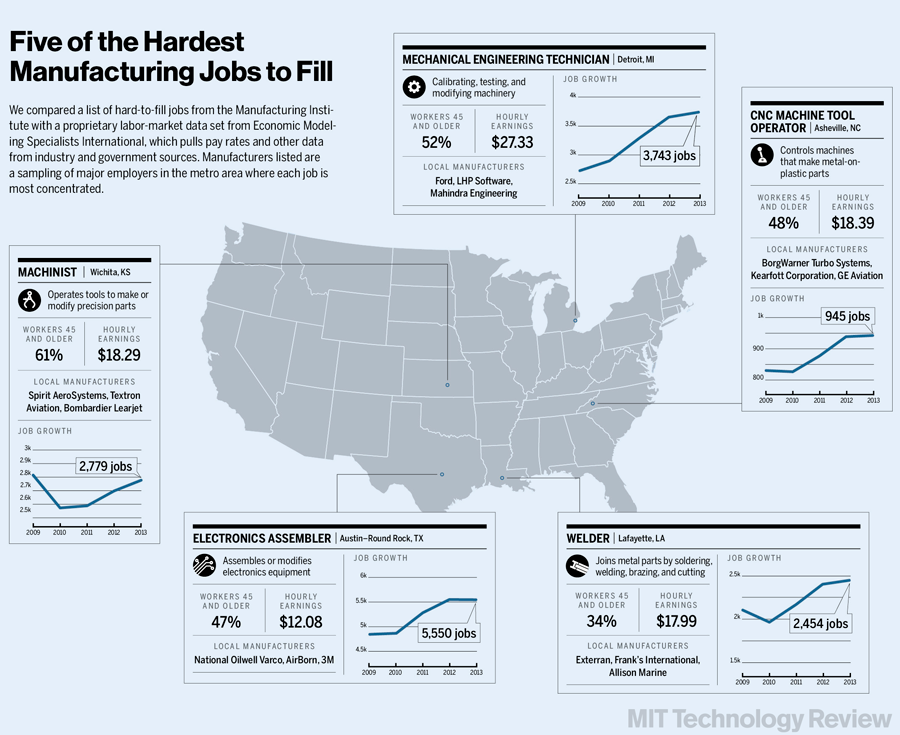The Hunt for Qualified Workers
Worried that U.S. workers are ill-prepared to work with new manufacturing technologies like 3-D printing and robotics, President Barack Obama has plans for a national program that over the next 10 years would build 45 hubs where manufacturing companies, community colleges, universities, and government agencies can prepare workers for the factories of the future.
The program underlines a growing concern that gaps in workers’ skills will hinder the current renaissance of American manufacturing. Although employment in the U.S. manufacturing sector dropped steadily from 2000 to 2010, manufacturing has added 646,000 net new jobs over the past four years, according to White House figures.

Though many firms are hiring, as of late June, 302,000 manufacturing job openings were unfilled, according to the U.S. Bureau of Labor Statistics. A skills shortage could grow more acute in the next few years. The Boston Consulting Group predicts that by 2020, the United States could face a shortfall of 875,000 highly skilled welders, machinists, machine mechanics, and industrial engineers.
The skills gap seems to be confined to a minority of smaller companies that require specialized skills, according to a 2013 report by MIT’s Production in the Innovation Economy study. The problem is not as pervasive as one might think given how much attention it has received, says Paul Osterman, a professor at MIT’s Sloan School of Management and a member of the commission that conducted the study.
Many of the specialized jobs that manufacturers are having the hardest time filling today involve conventional manufacturing tasks. Pipe fitters, mechanical engineering technicians, welders, machinists, electronics assemblers, and operators of computer-numeric-controlled machines are among the most needed workers identified in surveys conducted by the Manufacturing Institute, a nonprofit research affiliate of the Washington, D.C.–based trade association the National Association of Manufacturers.
As workers retire, it’s becoming harder to find people with these traditional skills, says Ben Dollar, a principal in Deloitte Consulting’s manufacturing practice.
For a smaller number of companies, the priority is getting workers up to speed on the skills they’ll need in tomorrow’s factories. In the last 18 months Siemens USA has donated more than $3 billion worth of manufacturing software to colleges in a bid to help train the next generation of advanced manufacturing workers.
Siemens itself plans to hire 7,000 more people in the U.S. by 2020. Their positions will be related to IT, software development, software engineering, and computer science, says Siemens USA CEO Eric Spiegel. “The digital world is coming, and it’s coming very fast,” he says. “There will be jobs. People may not count those jobs in IT and software development as manufacturing jobs, but they really are related to manufacturing.”
Keep Reading
Most Popular
Large language models can do jaw-dropping things. But nobody knows exactly why.
And that's a problem. Figuring it out is one of the biggest scientific puzzles of our time and a crucial step towards controlling more powerful future models.
The problem with plug-in hybrids? Their drivers.
Plug-in hybrids are often sold as a transition to EVs, but new data from Europe shows we’re still underestimating the emissions they produce.
How scientists traced a mysterious covid case back to six toilets
When wastewater surveillance turns into a hunt for a single infected individual, the ethics get tricky.
Google DeepMind’s new generative model makes Super Mario–like games from scratch
Genie learns how to control games by watching hours and hours of video. It could help train next-gen robots too.
Stay connected
Get the latest updates from
MIT Technology Review
Discover special offers, top stories, upcoming events, and more.